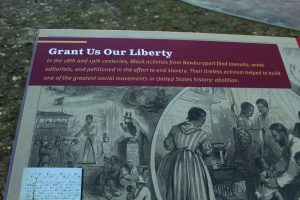NEWBURYPORT – The city has installed a new interpretive sign beneath the statue of the esteemed liberator, William Lloyd Garrison, pays tribute to the black activists, who, city planner Geordie Vining said, “made history, but were left out of the history books.”
The sign across from City Hall in Brown Square states: “In the 18th and 19th centuries, black activists from Newburyport filed lawsuits, wrote editorials, and petitioned to end slavery. Their tireless activism helped to build one of the greatest social movements in U.S. history: abolition.”
The sign is one of 10 being erected by the Newburyport Black Initiative around the city to educate residents and visitors about black activism in the 21st century.
Vining, Dr. Kabria Baumgartner, a professor at Northeastern University, and Cyd Raschke, wrote the narrative about the Newburyport black activists as part of the Newburyport Black History Initiative.
The narrative on the sign highlighted two individual residents – Caesar Sarter and Andrew Raymond.
During the summer of 1774, while the colonies were seeking their liberty from England, Sarter, a Newburyport resident who had been enslaved for 20 years, wrote in the Essex Journal and Merrimack Packet, “I need not point out the absurdity of your exertions for liberty, while you have slaves in your house.”
Sarter would also find it absurd or at least ironic that the new interpretative sign is in a park donated by Moses Brown. He was one of Newburyport’s wealthiest residents and philanthropists who indirectly earned his fortune importing rum that was traded for Africans destined for slavery in the American south. Brown owned several of the 10 rum distilleries in Newburyport at the end of the 18th Century.
The sign also discusses Andrew Raymond, a barber who lived prior to the Civil War in the Guinea Village with dozens of black residents. The founder of the Newburyport
Newburyport and Vicinity Anti-Slavery Society was founded by Andrew Raymond,
In the 1850s, Raymond presented a petition with 80 signatures against the statue of Daniel Webster. The statue was being considered by the legislature, but Webster had suggested a compromise that would permit slavery in new American colonies. This compromise delayed the separation of states from the union for a short time.
Different signs will highlight the experiences of Black Americans who resided and labored in Newburyport from before the Revolutionary War until the beginning of the 20th century.
During the unveiling of the first interpretative sign, Vining said, “History can get buried fast, particularly about ordinary people. But some of the stories remain and have survived at the edge of our vision. In this first sign, and in others that will profile people who came before us, we are trying to uncover some of these stories for all to see.”
Vining wrote that there are big stories inside the smaller stories of individual lives.
Newburyport historian Ghlee Woodworth wrote in her second volume of the city’s history that during the 1780s, there were 30 black men and 29 black women residing in the city. As the population grew to 10,000 residents in the early 1800s, 100 were African Americans. That was four times greater than the combined black population of surrounding communities.

Grant Us Our Liberty




